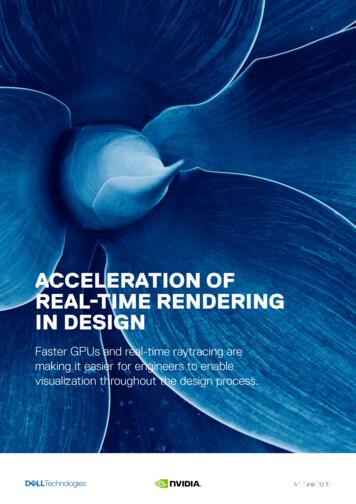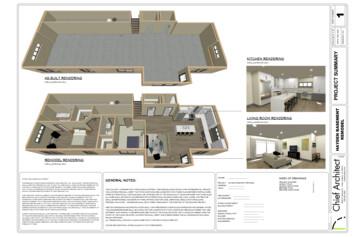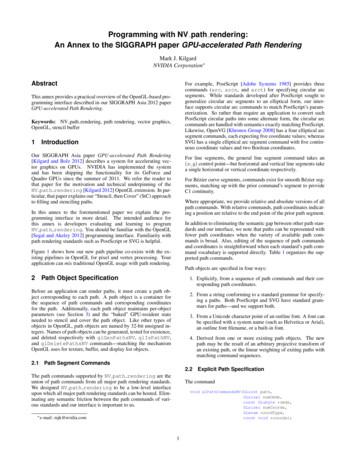ACCELERATION OF REAL-TIME RENDERING IN DESIGN
ACCELERATION OFREAL-TIME RENDERINGIN DESIGNFaster GPUs and real-time raytracing aremaking it easier for engineers to enablevisualization throughout the design process.1# June 2020
Last winter, Luxion released KeyShot 9, thelatest version of its CAD-friendly renderingsoftware. The release marked the software’sbreak from its exclusively CPU-basedtradition. For the first time, KeyShot userswere able to harness the GPU’s processingcores, with corresponding acceleration inrendering speed.“Users may toggle between GPU andCPU as needed. GPU ray tracing inKeyShot 9 supports the NVIDIA Maxwellmicroarchitecture found in the QuadroM6000 or GTX 980 and above with QuadroRTX 4000 or higher recommended,” writesLuxion in its blog post announcing therelease.By then, NVIDIA had released RTX-classGPUs with real-time raytracing. With itstimely GPU support, KeyShot brought thesame benefit to its users, adding accuracyand sophistication to the rendering results.Luxion’s own KeyShot brand plugins let usersinteract with its rendering tools directly fromfamiliar design and modeling programs, suchas Autodesk Fusion 360, Dassault SystemesSOLIDWORKS, PTC Creo, Onshape, SiemensNX, and Rhino. The coverage expands withthird-party plugins that also make KeyShotintegration possible with Siemens Solid Edge,Altair’s solidThinking, Alibre, IronCAD, andmore titles.This March, Autodesk announced that VRED,its virtual prototyping software packagefor automotive design, has added support2for RTX-powered real-time raytracing. Thefeature appears in VRED 2021.Lukas Fäth, Product Manager for VRED,wrote in a blog post, “We know that thetwo biggest challenges our customers faceare (1) that digital representations need tolook and behave as much like the physicalproduct as is possible, and (2) that themethods used to review physical prototypesneed to be transferred to the digital worldto provide the same benefit Being able toevaluate digital prototypes in real-time (inmotion) has a huge impact on the design andengineering processes in use today. It offersimmediate visual feedback to designers andengineers, with optimal interplay between adigital prototype and different variables in theenvironment, like lights, materials, viewingangles, and shadows.”Not all renderings are the same.Conventional rendering uses triangulatedmodels of objects to simulate colors,textures, lights, and shadows. By contrast,raytracing uses a method that traces thepath of light bounces, resulting in subtlereflections that replicate how light and colorsbehave on surfaces. It’s a computationintense process that previously softwareusers had to employ sparingly, reserving it forthe most extreme cases. But now that GPUsare becoming a standard part of professionalworkstations, real-time raytracing alsopromises to become commonplace amongdesign and modeling software users.
Luxion’s rendering program KeyShot began supporting GPU-based rendering in KeyShot 9. Shown hereis a rendering of the Stanley Blacker and Deckerpower drill. Image courtesy of Luxion.CADINTEGRATEDREALTIMERENDERINGThe integration of real-time rendering makesaesthetic judgements part of the design process. Without the need to export the CAD modelas STL, OBJ, or STEP model and prepare it forrendering in a separate program, CAD users caninstantly invoke real-time rendering to evaluatethe effects of a design decision, such as addinga new surface or switching to a new material. Itadvances the use of digital prototypes to makecritical decisions.Once a feature available only in dedicated rendering programs, real-time rendering is now almost astandard feature in 3D design software. AutodeskFusion 360, an integrated CAD-CAM-CAE suite,offers as part of its design documentation tools.The drag-and-drop menu allows you to selectappropriate materials (steel, plastic, wood, etc.),apply it to the CAD model, and see the resultinstantaneously.Dassault Systemes SOLIDWORKS takes a similarapproach with its SOLIDWORKS Visualize toolset, available in SOLIDWORKS Professional andPremium editions. Last October, SOLIDWORKSannounced, “Visualize 2020 SP0 is the firstpublicly available production release of SOLIDWORKS Visualize to take full advantage of NVIDIA RTX technology In our own performancebenchmarks, we’ve seen an average of 30%speed improvements with Visualize 2020 over2019 SP4 on the same RTX hardware! Somescenes show improvements of up to 50%! That’sa remarkable increase in render performance.”3Visualize 2020 SP0 is the firstpublicly available productionrelease of SOLIDWORKSVisualize to take fulladvantage of NVIDIA RTXtechnology
RAYTRACEDRENDERINGLast winter, Chaos Group announced its renderer V-Ray will begin usingthe RTX GPU’s real-time raytracing feature. Since V-Ray has directintegration programs and plug-ins to various modeling and animationpackages, it further pushes real-time raytracing to a wider modelingcommunity.“Our RTX support begins today in V-Ray Next for 3ds Max, update3, V-Ray Next for Maya, update 2, V-Ray Next for SketchUp, update2 and V-Ray Next for Rhino, update 2, and it’s free to current V-RayNext for 3ds Max, V-Ray Next for Maya, V-Ray Next for SketchUp andV-Ray Next for Rhino customers. RTX support for our other V-Rayproducts is in the works,” announced Chaos in a blog post. “With anaverage speed-up of 40%, we think our RTX support is off to a greatstart, as it’s already better than what you typically get with a new GPUgeneration.”The company is also beta-testing Project Lavina (now in Beta 2),a platform for delivering real-time raytraced 3D environments builtas V-Ray scenes. At SIGGRAPH 2019 in Los Angeles, California,the company showed off Project Lavina with a one-billion-polygonKitBash3d city (created by Blizzard Entertainment’s Evan Butler) anda fully interactive walkthrough of a virtual construction site (from 3Dartist Kevin Margo’s film).“Project Lavina can fully ray-trace massive 3D scenes withoutworkarounds or raster graphics. Artists simply drag and drop theirV-Ray scenes to explore them immediately in real-time—without thecomplex setup of a game engine,” said Chaos in its announcement. Thispositions Project Lavina as a rival to the two leading game engines,Unity and Unreal.Visualizing detailed 3D scenes is a standard practice in filmmaking andgame development, but less so in design and engineering. However,now that the use of simulation to develop autonomous robots andvehicles is increasing, real-time rendering of scenes (of roads andhighways or factory interiors, for example) could become morecommon.4With an averagespeed-up of 40%,we think our RTXsupport is off to agreat start, as it’salready better thanwhat you typicallyget with a new GPUgeneration.
ESSENTIALINGREDIENTIN DESIGNLast year, analyst Jon Peddie Research (JPR)released its report on the “Global Market forRaytracing Software.” The firm estimates thenumber of 3D rendering software users to be 2.1million.“For certain types of design, ray tracing is notdesirable but demanded. For example, in the design of optical systems (lens, mirrors, and othercomponents), jewelry design, lighting fixtures,and lamp design. In addition to such physicaldesigns, there is a field of ray tracing for waveand field design in radio and acoustics. In theseexamples, the design, and resultant images anddata must be absolutely physically accurate andphotorealistic,” wrote JPR.Resources:5
2 and V-Ray Next for Rhino, update 2, and it’s free to current V-Ray Next for 3ds Max, V-Ray Next for Maya, V-Ray Next for SketchUp and V-Ray Next for Rhino customers. RTX support for our other V-Ray products is in the works,” announced Chaos in a blog post. “With an average sp
this drawing is owned and/or licensed by chief architect, inc. and is solely for demonstrative . as-built rendering for illustration only remodel rendering for illustration only kitchen rendering for illustration only living room rendering for illustration only. 6050 4050 6050 7 0 1 9 5 3 1 9 2 1 0 5 0 3 0 6 8 4060 4060 4050 3068 3068 up e1 .
redraws per second. If the 3D graphics are rendered and displayed fast enough so that the user can interact with them, then it is called real time. 2.1 Software Rendering vs. Hardware Accelerated Rendering There are two main ways to render 3D graphics: Software rendering † Hardware accelerated rendering 2.1.1 Software Rendering
Rendering Techniques in 3D AutoCAD , Part 1 4 Rendering Basics Rendering can be a very time-consuming aspect of a project. Because of the subtleties involved, you can spend a lot of time adjusting camera positions, lighting, and materials. In the past, you might spend more time creating a rendering than you spent actually building the 3D model.
3.1 Which of the following statements correctly defines acceleration? Question 1 A. Acceleration is the rate of change of displacement of an object. B. Acceleration is the rate of change of velocity of an object. C. Acceleration is the amount of distance covered in unit time. D. Acceleration is the rate of change of speed of an object. Section .
Centripetal Acceleration" The acceleration of an object moving in a circular path and at constant speed is due to a change in direction." An acceleration of this nature is called a centripetal acceleration. CENTRIPETAL ACCELERATION ac vt 2 r centripetal acceleration (tangential speed)2 radius of circular path Section 1 Circular Motion
GPU-accelerated Path Rendering. Keywords: NV path rendering, path rendering, vector graphics, OpenGL, stencil buffer 1 Introduction Our SIGGRAPH Asia paper GPU-accelerated Path Rendering [Kilgard and Bolz 2012] describes a system for accelerating ve
So, what is better with strand-based rendering? Strand based rendering, where hair fibers are modelled as individual strands, or curves, is the current state of the art when rendering hair offline. And it can look something like this image generated using Arnold. Modelling hair as strands has a lot of benefits for physics and rendering since it .
Real-time rendering of massive 3D scenes lies at the forefront of graphics research. In this paper we present new algorithm for real-time rendering of large polygonal meshes. To our knowledge, this is the first out-of-core view-dependent mesh renderer that supports texture mapping and continuous smooth transitions between LODs to prevent























